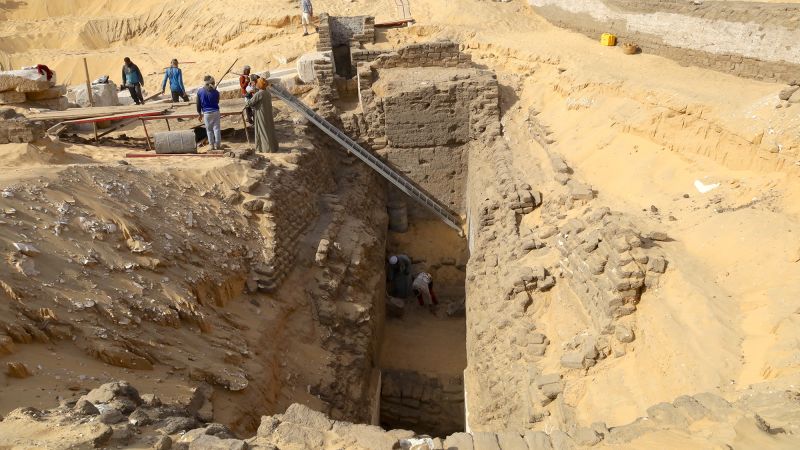The recent unearthing of an ancient Egyptian tomb is illuminating a pivotal yet obscure chapter in Egypt’s royal history that dates back over 3,600 years. Discovered in January 2023 in Abydos, a site rich with the remnants of Egypt’s distant past, this substantial limestone burial chamber is composed of multiple rooms and features a decorated entryway, filling a vital gap in the narrative of the region’s ruling class during the Second Intermediate Period.
Located about 23 feet underground in what was once a thriving necropolis, this mysterious tomb is currently lacking the skeletal remains that could provide crucial insight into its intended occupant. Although archaeologists have yet to identify its owner, evidence suggests it likely belonged to a king from the Abydos Dynasty, a lineage that has puzzled historians and Egyptologists alike. This dynasty, often overshadowed by more prominent rulers, was thought to exist during a tumultuous era from around 1640 to 1540 BC, marked by political fragmentation and decay.
Josef Wegner, an Egyptologist and a leading figure in this excavation from the University of Pennsylvania, commented on the enigmatic nature of the Abydos Dynasty, asserting that the newly found tomb may spark fresh inquiries into this obscured part of history. “It’s a very sort of mysterious, enigmatic dynasty that seems to have basically been sort of forgotten from the ancient records of Egypt,” Wegner stated. The grandeur of the burial chamber emerges as a significant find, as it is the largest discovered from any monarch of the Abydos Dynasty to date, which raises tantalizing questions about the political landscape of the time and the nature of the leadership during an era of incomplete historical records.
Abydos, often regarded as a sacred city, holds substantial significance in ancient Egyptian culture as the resting place of Osiris, the god of the underworld. This site’s history as a burial ground expanded over centuries, accommodating numerous dynasties and their rulers within its royal cemetery. The discovery has been met with excitement in the academic community, demonstrating the potential for greater understanding of the Abydos Dynasty, activated by earlier excavations that confirmed its existence nearly a decade ago.
Previously, two rulers, King Senaiib and King Paentjeni, surfaced in sparse archaeological findings linked to the dynasty, leading researchers to propose that the new excavation could reveal more about the rulers from that time. Wegner speculates that the newly uncovered tomb, architecturally comparable to King Seneb-Kay’s tomb—discovered earlier—might belong to one of his predecessors, hinting at a further convoluted genealogy within the Egyptian monarchy.
The lack of apposite inscriptions or markings that might clarify the tomb’s previous occupant adds to the mystique, yet the presence of painted images of the goddesses Isis and Nephthys enriches our understanding of the funerary practices and cultural beliefs surrounding the deceased. As scholars aim to gain more insights, the researchers are preparing to explore up to 10,000 square meters of the surrounding desert using advanced technologies like ground-penetrating radar and magnetometry.
As history holds its breath regarding the identities of these obscure kings, esteemed Egyptologist Salima Ikram expressed her enthusiasm for the potential findings. She highlights the significance of these discoveries in reconstructing the architectural characteristics of royal tombs and the hierarchical structure of the ancient dynasty. While some seasoned historians, such as Laurel Bestock, articulate that the conventional king lists of ancient Egypt do not acknowledge these lesser-known rulers, the findings may provide a more textured historical backdrop that transcends the limited narratives previously honored by historical documents.
In conclusion, while the identity of the illustrious king associated with this newly discovered burial chamber remains uncertain, Wegner’s dedication to unearthing further evidence gives hope that the enigmatic Abydos Dynasty might one day be more comprehensively chronicled. Each excavation and discovery promises to reveal intriguing complexities pertaining to leadership, ideologies, and cultural practices in a society that once held dominion over one of the earliest civilizations in history. The growing body of evidence continues to unveil a richer, more intricate tapestry of ancient Egypt’s regal past.











